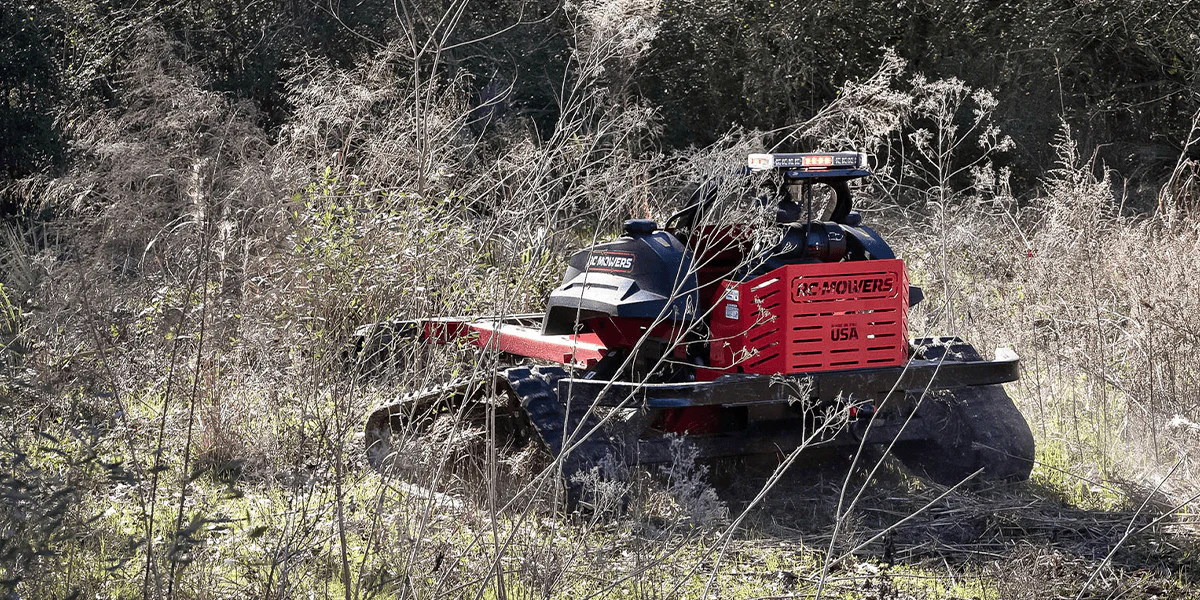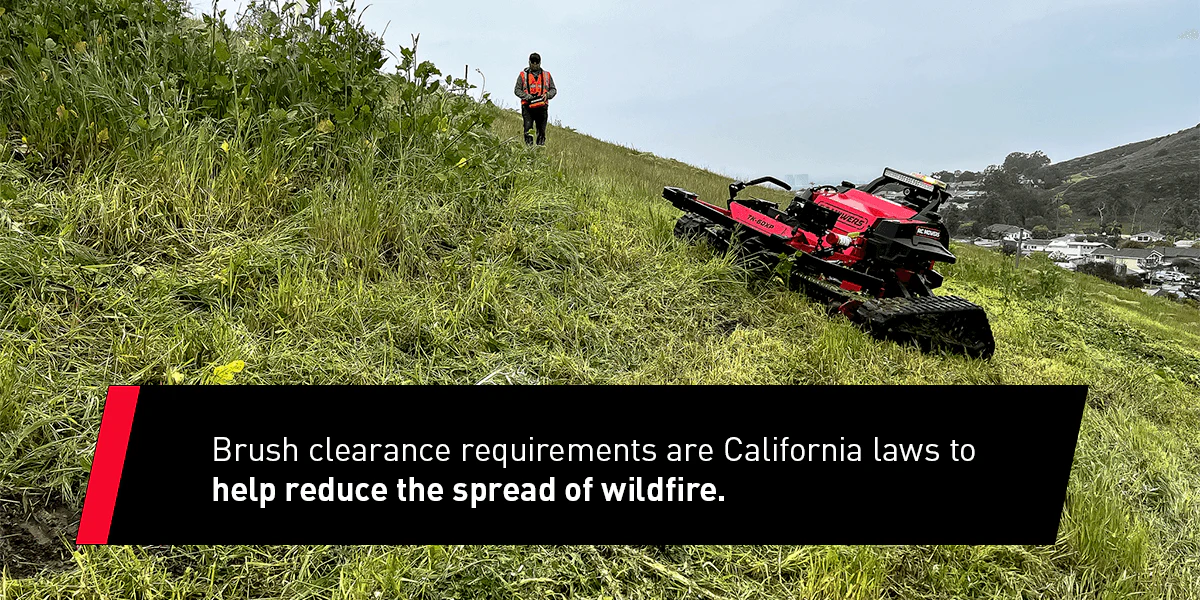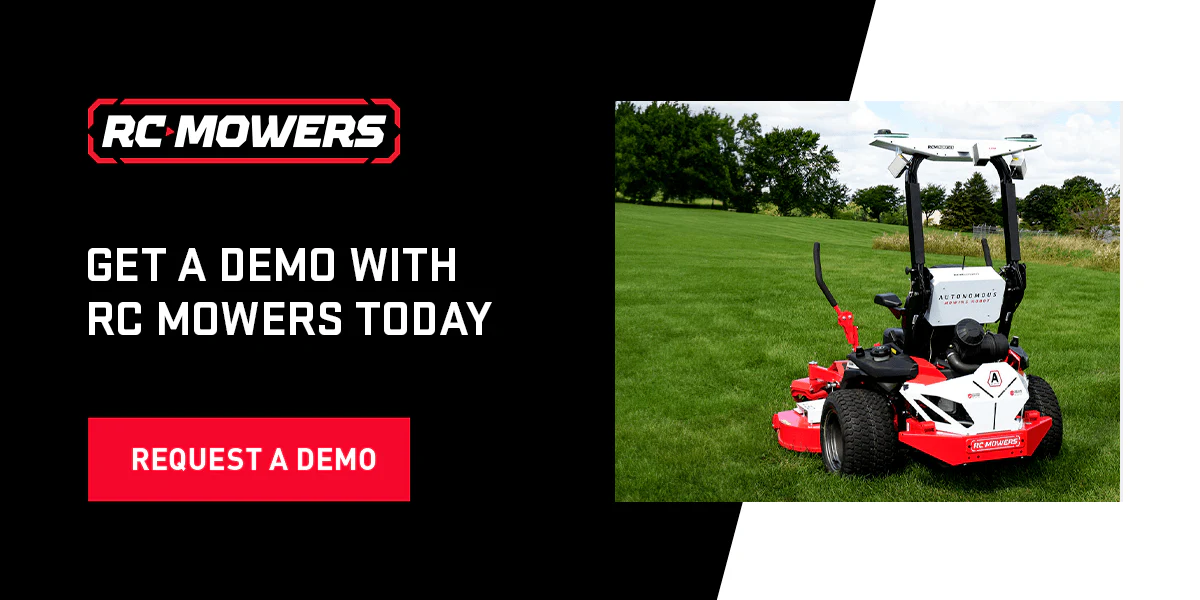Everything You Need to Know About Fire Clearance Requirements

Table of Contents
- What Are Brush Clearance Requirements?
- What Happens if You Don't Pass Brush Clearance Inspection?
- The Best Time of Year to Clear Brush
- Brush Clearance and Insurance
- Your Options for Managing Brush
- Remote-Operated Robotic Mowers — Brush Clearance Made Easy, Efficient, and Safe
- Get a Demo With RC Mowers Today
Table of Contents
- What Are Brush Clearance Requirements?
- What Happens if You Don't Pass Brush Clearance Inspection?
- The Best Time of Year to Clear Brush
- Brush Clearance and Insurance
- Your Options for Managing Brush
- Remote-Operated Robotic Mowers — Brush Clearance Made Easy, Efficient, and Safe
- Get a Demo With RC Mowers Today
When it comes to fire clearance requirements (and the fees for noncompliance), knowing the facts is essential. Living in California comes with wildfire risk, and legal requirements are designed to keep your property and neighborhood safe. Learn everything you need to know about brush clearance and how you can maintain your property like a law-abiding pro.
What Are Brush Clearance Requirements?
Brush clearance requirements are California laws to help reduce the spread of wildfire. Generally, these requirements focus on clearing out anything on a property that could easily catch fire, like dry brush and loose branches. Details include:
- Grass heights and native brush must be kept at 3 inches or shorter within 200 feet of structures.
- Trees taller than 18 feet must have branches trimmed 6 feet from the ground. For shorter trees, the lower third of the tree must be kept clear.
- Trees should be trimmed to keep foliage 10 feet or farther from chimneys.
- All roofs should be cleared of combustible matter, such as leaves, needles, and twigs. There should also be 5 feet of clearance between roofs and overhanging trees.
- Debris and cut vegetation should be disposed of in a safe and legal way.
- Property owners should keep an approved fire extinguisher or pressurized garden hose within 10 feet of any grass or brush clearing operation.
These requirements depend on the fire hazard severity zones. These zones determine how high the risk is for wildfire in local responsibility areas (LRAs). Areas with Very High Fire Hazard Severity Zones have to follow these brush clearance requirements. Local fire departments in California complete annual inspections starting on May 1st to make sure all properties align with these rules.
What Happens if You Don't Pass Brush Clearance Inspection?
Your local fire department will present a notice of noncompliance if your property doesn't meet brush clearance standards. You'll have 15 days after receiving this notice to complete the necessary actions, and you'll be charged a small noncompliance fee. You have the option to request a second inspection before the 15 days are up, or the fire department will automatically reinspect after the notice period.
If you've checked all the boxes after the second inspection, you'll receive a Cleared-by-Owner notice in the mail. If you still fail the inspection in the second round, this is where the heftier noncompliance fees come into play. First, you'll receive a second reinspection fee that's much higher than the first fee — generally hundreds of dollars. After this assessment, the fire department will hire a private contractor to clear the property, and you'll be billed the contractor's lowest bid price and an administrative fee that's well in the thousand-dollar range.
This much is clear — not clearing inspection and noncompliance are costly.
The Best Time of Year to Clear Brush
Brush clearing is obviously important, but when should you do it? Inspections begin on May 1st, so it's in your best interest to handle brush clearing before that date. However, there are some conditions to consider.
Never clear brush on red flag days when fire weather conditions are at their peak. Red flag days are more likely to happen in the summer, but they can still happen before May 1st. The best time to start clearing your brush is mid to end of winter when wildfire risk is likely at its lowest.
It's also important to maintain your brush clearing. This isn't a one-and-done operation, but a process that happens throughout wildfire season. On planned maintenance days, check your local fire weather conditions before diving in.
Brush Clearance and Insurance
Brush clearance isn't just a compliance issue — it's also wrapped up in insurance. Overall, it's pretty tough to find an insurance company that will offer wildfire coverage when you're in a High Fire Hazard Severity Zone.
The California FAIR Plan is an option for high-risk properties needing fire coverage. They connect you to insurers outside of the traditional marketplace, so your property will be covered in the event of a wildfire.
Note that these plans are often used as temporary safety nets and may include higher premiums. Plus, your policy may outline terms for maintenance to ensure you're reducing your risk of spreading fire. Your insurer will likely require you to keep up with state maintenance requirements at a minimum, and they may have additional rules to follow.
Your Options for Managing Brush
It's clear that maintaining the brush on your property is nonnegotiable. But it's up to you to decide how to handle it. There are really only two options: do it yourself or hire a contractor. While a contractor is nice for saving time, it's typically not the most cost-effective option, especially if you hire one regularly. Those bills from a contractor can add up over time, particularly if you plan on staying put for many years into the future.
Remote-Operated Robotic Mowers — Brush Clearance Made Easy, Efficient, and Safe
RC Mowers has a way for you to manage brush that's easier and more cost-effective — the R Series Remote-Operated Robotic Mower. This powerful machine navigates steep slopes and rips through rugged brush while one person operates from a safe, stable distance. Designed for the harshest terrain, the R Series features a cast iron spindle and an impressive first-pass yield.
The remote control has an LCD screen with real-time information, plus neck and waist straps for operator comfort. Run an R Series machine for up to 20 hours on one hour of charge, and simply dominate the fire risk on your property without breaking a sweat.
Why choose the R Series for brush cutting?
- It's safe: Dry brush and old branches are dangerous and can cause injury to anyone trying to manage this terrain with a string trimmer. Its ability to climb slopes up to 50° eliminates riding mower rollover hazards. The R Series is designed to tackle the roughest brush, so you don't need to put yourself on the line.
- It's easy: Mowing a big property is labor-intensive. Whether you tackle it yourself or with others, it's going to take time. When the R Series does the work, you only need one operator working safely and completing the task in a fraction of the time.
- It’s smart: The R Series mower cuts and mulches vegetation in a manner that greatly reduces the possibility of cut materials igniting.
- It's cost-effective: Given the time you save, the lack of hefty contractor bills, and the money saved by avoiding noncompliance fees, the R Series pays for itself.
Get a Demo With RC Mowers Today
Keeping your California property and neighborhood safe from wildfire doesn't have to be a headache. With the Remote-Operated Robotic Mower, you have to see it to believe it. Request a demo today.


